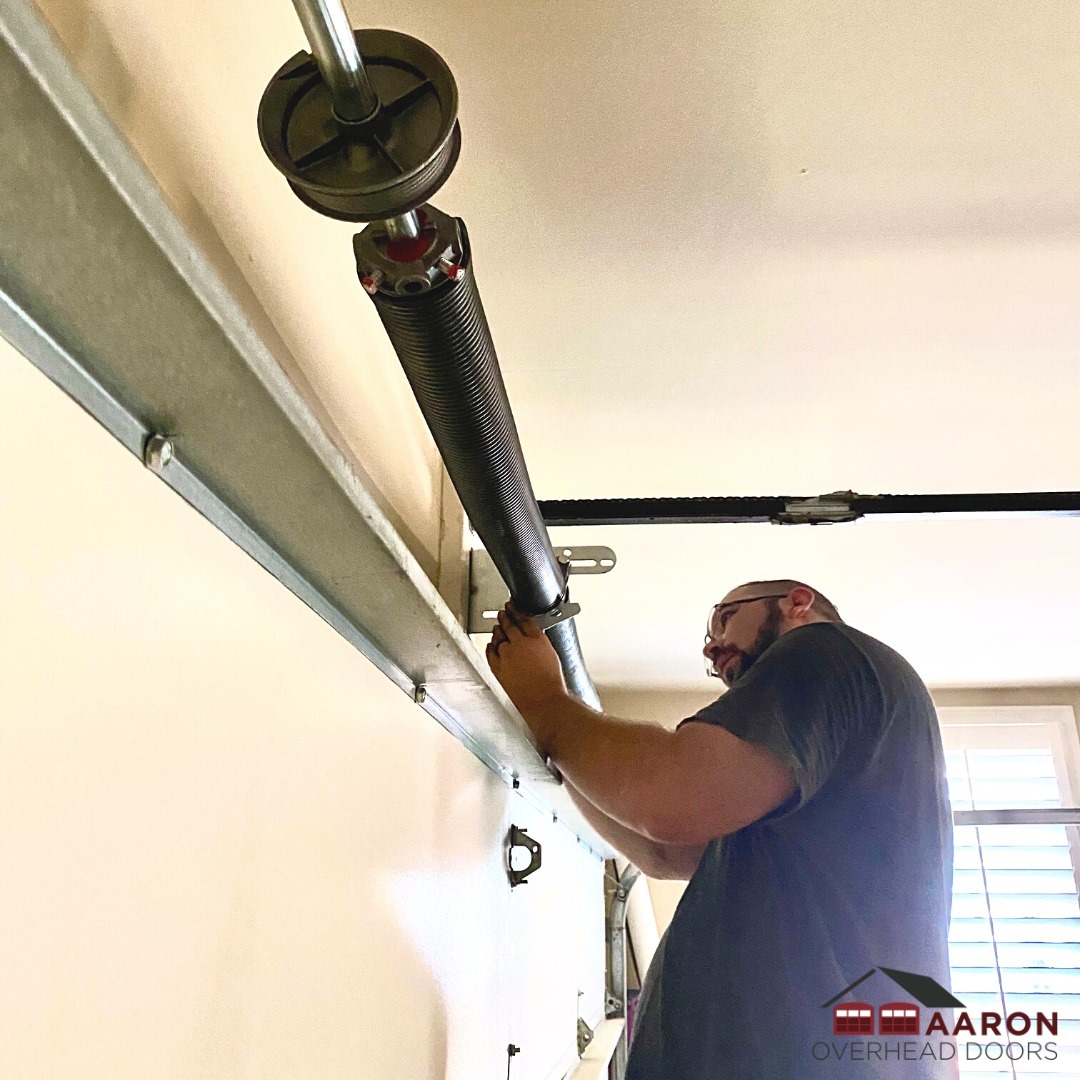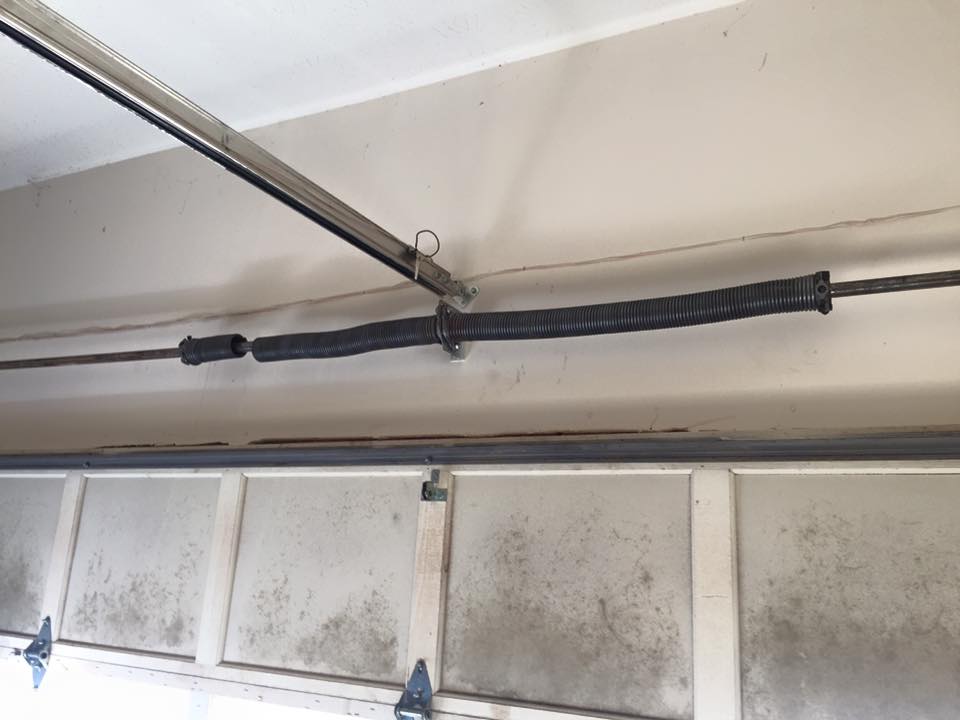Garage Door Spring Replacement
Receive a FREE Quote Today!
Call or Text For Service 678-960-3360
How Do You Know You Need Garage Door Spring Repair?
When your garage door won’t open or your garage door comes up at an angle, you likely need a garage door spring replacement or repair. The most common signs you have a broken garage door spring include:
- Your garage door won’t open.
- Your garage door opens halfway and stops.
- You notice fallen or loose garage door cables.
- Your garage door is really heavy when you try to manually open it.
- Your garage door slams down suddenly when it tries to open.
- Your garage door goes up crookedly or at an angle.
- There is a 3 – 4″ gap between the garage door spring’s coils.
- Your garage door spring is elongated.
Our Garage Door Spring Replacement Services
Extension and torsion springs are the most common spring types found in Buford, Milton, and Buckhead, GA homes. Our Aaron Overhead Doors team specializes in repairing, replacing, and maintaining both types of springs, as well as Wayne Dalton Torque Master springs. Learn more about our garage door spring replacement services below, and contact us with any questions!
Torsion Spring Replacement
Torsion springs are becoming an industry standard for new garage door installations. They tend to last longer and hold more weight than standard extension springs. Torsion springs will be located above your garage door towards the middle, running horizontally. For seven to eight-foot doors, you will only have one spring. For larger, two-car-wide doors, you will most likely have two springs. However, this number can also depend on the weight and material of your garage door.
Extension Spring Replacement
If you have extension springs, they will be located to the left and right of your garage door, running vertically. These run along pulleys, extending down and back in order to operate your garage door. For this type of garage door spring, you will always have two installed in your garage system. Extension springs work together as independent parts in order to create the counterbalance system with your cables and opener.
Wayne Dalton Torque Master Conversion
Wayne Dalton springs are not visible because they are contained inside a torsion tube. They are a specialized type of spring specific to the Wayne Dalton garage door line. We usually suggest getting a Wayne Dalton conversion if you have this system. When this type of spring breaks, you can usually see your garage door cables hanging loose. Additionally, you can try to lift the garage door manually. If it is heavy, then your spring is most likely broken.

Garage Door Spring Repair Near You!
FREE Quote / Inspection
What Causes Garage Door Springs to Break?
- Wear and Tear – The primary reason your garage door spring breaks is because of wear and tear over time. Garage door springs are built to last 10-15,000 cycles of opening and closing your garage door. This translates into 7-10 years depending on how frequently you use your garage door. At the end of this life span, your extension and torsion springs will inevitably need garage door spring replacement.
- Poor Maintenance – Yes, wear and tear over time is inevitable with your garage door, but poor garage door maintenance can also shorten the life of your extension and torsion springs. That is why your automatic garage door needs annual tightening, lubricating, and balancing to operate at its best. These steps can also lengthen the lifespan of your garage door springs by years.
- Rust Build-Up – Part of the importance of regular maintenance is that it prevents rust build-up on your garage door springs. Without proper lubrication, rust develops on your springs, creating extra friction. This causes your garage door springs to wear down more quickly.
- Unbalanced Parts – To operate at its best, your garage door needs to be properly balanced between the springs, cables, and opener. However, your garage door can become unbalanced over time, putting extra strain on one or both of your garage door springs. The added weight and tension will shorten the lifespan of your garage door springs.
Why You Shouldn’t Delay Garage Door Spring Repair
Have you noticed your garage door has become extra noisy or seen a small break in the garage door spring? These may seem like minor garage door repairs you can delay, but they are signs of major issues with your automatic garage door system. If you continue to use the garage door with a broken garage door spring, you are creating larger problems for yourself down the road.
First, a broken garage door spring is a safety risk. It could snap completely at any time, sending your garage door crashing down, and potentially injuring someone. Second, a broken garage door spring will put extra strain on your garage door opener. This shortens the lifespan of your garage door opener, creating a need for garage door opener replacement sooner. But you should know that garage door spring replacement is a much more affordable repair than garage door opener replacement.
So instead of delaying garage door spring replacement, call the experts at Aaron Overhead Doors at the first sign of an issue. By performing your garage door spring replacement quickly we increase the safety of your garage and save you money in the future.

What Can You Do to Test Your Springs?
A door balance test measures how well your garage door springs are functioning. A garage door requires balance because the springs have to have the right amount of tension to hold the garage door. The garage door cannot be too heavy or too light. If your garage door doesn’t have the right balance, it can put pressure on your garage door springs and cause them to wear out faster. This in turn can damage your garage door opener.
There are several signs of an unbalanced door including uneven or slow opening or closing and strange noises. All of these signs mean that weight of your door is not being evenly distributed. This means unnecessary strain is building up and may cause your system to break. To perform a door balance test before any of these symptoms get worse follow these steps:
- Close your garage door with you inside.
- Disengage your garage door from the opener by pulling the manual release rope that hangs down.
- Manually open and close the garage door. It should move smoothly, although it may need some lubrication around the rollers and hinges.
- Lift your garage door to the halfway point and release it. If it remains in place, your garage door springs are doing their job to balance the door. If it falls to the ground, then your garage door is out of balance. You can also repeat this test with your door at knee, waist, and chest height to ensure everything is running smoothly.
- Reengage your opener by pulling on the manual string.
If you do not feel comfortable completing this test, we would be happy to perform it for you during an annual garage door maintenance appointment. We perform this and many other steps to check your garage door parts, ensuring their function and reliability long term. Contact us at 678-960-3360 to book your appointment and visit our Maintenance page to learn more.
A Few Things That Help Us When You Call
One
Is your garage door wood or steel?
The material of your garage door determines its weight. Wood doors tend to be very heavy while steel doors are lighter. Knowing the material will help us select the best gauge of spring to support your door.
Two
Double-car vs. single-car wide door?
The width of your garage door will help us determine how many springs your system needs. Even if you only have one spring currently, we can offer you upgrades in order to help your extension and torion springs and opener last longer.
Three
Do you have one spring or two springs?
This question helps us know if you have torsion or extension springs already installed in your garage. From there, we can ensure we find the right replacement springs in stock to fix your door.





